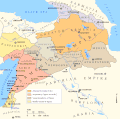Kingdom of Armenia (antiquity)
Armenia, also the Kingdom of Greater Armenia,[6] or simply Greater Armenia or Armenia Major (Armenian: Մեծ Հայք Mets Hayk;[7] Latin: Armenia Maior) sometimes referred to as the Armenian Empire, was a kingdom in the Ancient Near East which existed from 331 BC to 428 AD. Its history is divided into the successive reigns of three royal dynasties: Orontid (331 BC–200 BC),[8][9] Artaxiad (189 BC–12 AD)[10][11][12] and Arsacid (52–428).[13]
This article is about the Kingdom of Armenia during classical antiquity. For a list of other Armenian Kingdoms, see Kingdom of Armenia (disambiguation).
Armenia
Մեծ Հայք
Մեծ Հայք
Armavir (331–210 BC)
Yervandashat (210–176 BC)
Artashat (176–77 BC; 69–120 AD)
Tigranocerta (77 BC–69 AD)
Vagharshapat (120–330)
Dvin (336–428)
Armenian (spoken native language)[1]
Greek
Aramaic[2]
Iranian languages (Parthian and Middle Persian)
- Zoroastrianism[3]
(331 BC–301 AD)
- Christianity (Armenian Church) (301–428)
Monarchy
c. 533 BC
331 BC
63 AD
301 AD
387 AD
428 AD
900,000 km2 (350,000 sq mi)
311,000 km2 (120,000 sq mi)
10,000,000
4,000,000
Taghand
The root of the kingdom lies in one of the satrapies of the Achaemenid Empire of Persia called Armenia (Satrapy of Armenia), which was formed from the territory of the Kingdom of Ararat (860 BC–590 BC) after it was conquered by the Median Empire in 590 BC. The satrapy became a kingdom in 321 BC during the reign of the Orontid dynasty after the conquest of Persia by Alexander the Great, which was then incorporated as one of the Hellenistic kingdoms of the Seleucid Empire.
Under the Seleucid Empire (312–63 BC), the Armenian throne was divided in two—Greater Armenia (state) and Sophene—both of which passed to members of the Artaxiad dynasty in 189 BC. During the Roman Republic's eastern expansion, the Kingdom of Armenia, under Tigranes the Great, reached its peak, from 83 to 69 BC, after it reincorporated Sophene and conquered the remaining territories of the falling Seleucid Empire, effectively ending its existence and raising Armenia into an empire for a brief period, until it was itself conquered by Rome in 69 BC. The remaining Artaxiad kings ruled as clients of Rome until they were overthrown in 12 AD due to their possible allegiance to Rome's main rival in the region, Parthia.
During the Roman–Parthian Wars, the Arsacid dynasty of Armenia was founded when Tiridates I, a member of the Parthian Arsacid dynasty, was proclaimed King of Armenia in 52. Throughout most of its history during this period, Armenia was heavily contested between Rome and Parthia, and the Armenian nobility was divided among pro-Roman, pro-Parthian or neutral factions. From 114 to 118, Armenia briefly became a province of the Roman Empire under Emperor Trajan. The Kingdom of Armenia often served as a client state or vassal at the frontier of the two large empires and their successors, the Byzantine and Sassanid empires. In 301, Tiridates III proclaimed Christianity as the state religion of Armenia, making the Armenian kingdom the first state in history to embrace Christianity officially.
In 387, Armenia was partitioned into Byzantine Armenia and Persian Armenia. The last Arsacid king of Armenia was deposed in 428, ending independent Armenian statehood until the emergence of Bagratid Armenia in the 9th century.







